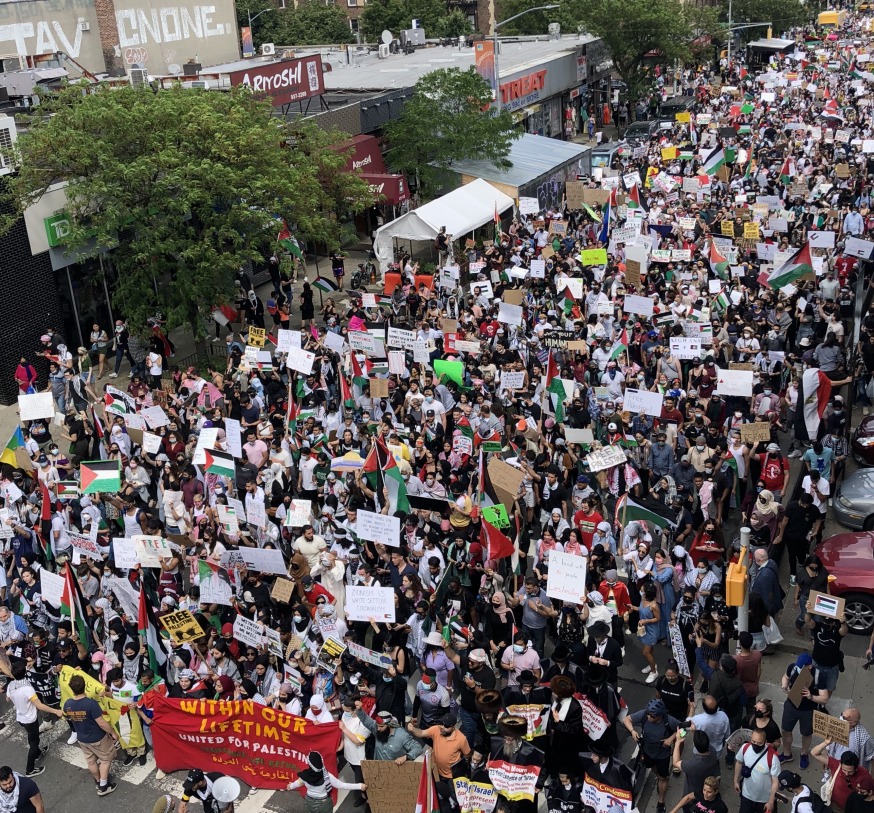
Thousand marched down Queens Boulevard in Sunnyside Saturday in a display of solidarity for Palestinians (Photo: Christina Santucci)
May 23, 2021 By Christina Santucci
Thousands of people marched through the streets of Queens from Sunnyside to Astoria Saturday afternoon in support of Palestinians.
Within Our Lifetime – a Palestinian-led community organization that also held a large rally in Bay Ridge last week – organized the event, which began at Queens Boulevard and 46th Street.
Saturday’s march came just days after Israel and Hamas agreed to a ceasefire that ended more than 10 days of violence and bloodshed in the decades-long conflict. More than 230 Palestinians — including over 60 children — have been killed in Israeli airstrikes and 12 Israelis died in rocket attacks launched by Hamas, the New York Times reported.
In Queens, demonstrators initially gathered underneath the No. 7 train station at 46th Street – just steps from the Sunnyside Arch. Many wore keffiyehs – black and white checkered scarves –that symbolize Palestinian nationalism.
Thousands participated in a rally in Sunnyside Saturday in a display of solidarity for the Palestinians pic.twitter.com/xAomcZZrtQ
— QueensPost (@queenspost) May 23, 2021
Following a prayer for Muslim attendees, organizers led more than a dozen of chant. “Not another nickel, not another dime, no more money for Israel’s crimes,” one rally leader bellowed into a loudspeaker, as attendees repeated. Other chants included ‘Hey, Hey, Ho, Ho, Zionism has got to go’ and ‘Resistance is justified when people are colonized.’
Supporters flocked to the event from Queens and beyond – with many like Brooklyn resident Farhana Akther saying that they chose to attend to show solidarity with Palestinians.
Many were from the world’s borough.
“We love them and support them,” said Jamaica resident Kazi Fuzie. “We want to ask the government to stop spending our tax dollars to fund Israel.” She called on federal officials to redirect funding to domestic issues like education and housing.
Attendees also included members of Neturei Karta, a group of Orthodox Jewish people who opposed the State of Israel, as well as representatives from the December 12th Movement, a Black human rights organization based in New York City.
Demonstrators carried Palestinian flags and signs with a variety of messages – such as “From the River to the Sea, Palestine will be Free,” “No Peace on Stolen Land,” and “Never Again Means Freedom for All – Jews for Palestine.”
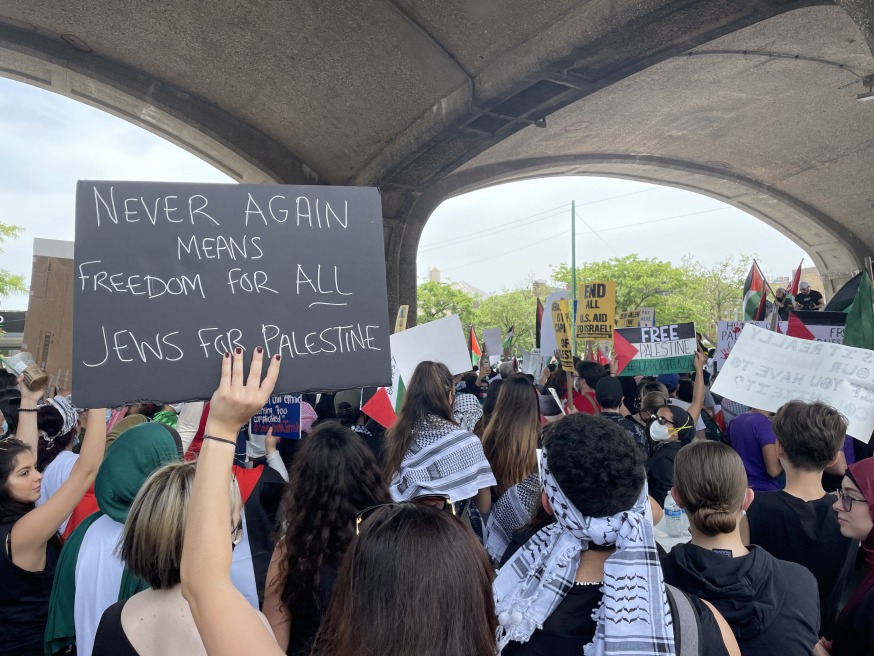
Demonstrators carried Palestinian flags and signs with a variety of messages – such as “From the River to the Sea, Palestine will be Free,” “No Peace on Stolen Land,” and “Never Again Means Freedom for All – Jews for Palestine.” (Photo: Queens Post)
Some carried the flags of Morocco, Bangladesh, Algeria, Turkey and Iraq, and others shared messages of support from other countries – such as one woman who held a “Bosnians for Palestine” sign and another attendee who carried a poster that read, “Afghans 4 Palestine.”
A handful of supporters addressed the crowd before the group began its march. Two related the situation in Palestine with that in Colombia, where at least 42 people have been killed in recent weeks during anti-government protests.
“So we have to be connecting with each other’s struggles – right here in the belly of the beast,” said Yhamir Chabur. “Colombia’s liberation is connected with Palestine’s liberation.”
Demonstrators also likened support for Palestine to that for Black Lives Matter and indigenous peoples.
Once the march began, a UHaul pickup truck led the way as several organizers stood atop the vehicle and waved Palestinian flags. Participants first proceeded west on Queens Boulevard then headed north on 39th Street into Astoria. Passing cars that honked in support were met with rounds of cheers.
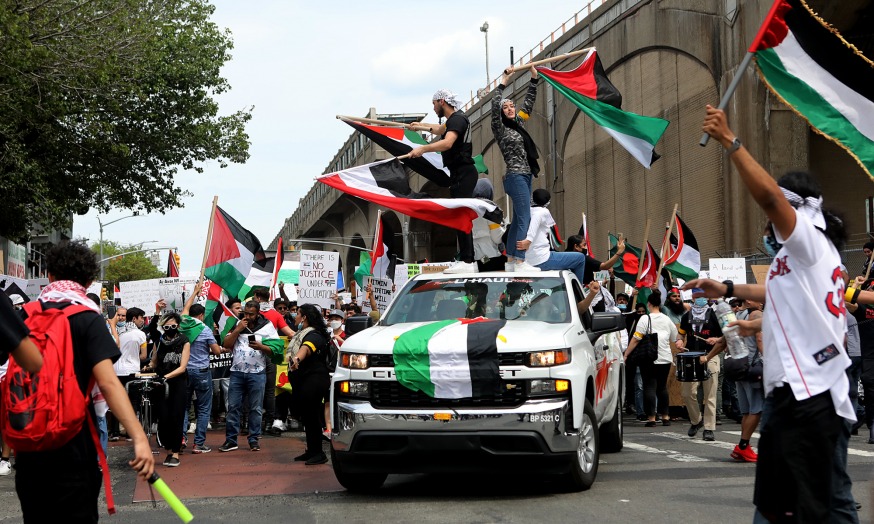
A UHaul pickup truck led the way as several organizers stood atop the vehicle and waved Palestinian flags (Photo: Christina Santucci)
One attendee said she had expected that the Queens event would be smaller than others held in Brooklyn. “The turnout is actually impressive,” she said.
The event also drew several Sunnyside City Council candidates – including Steven Raga, Amit Bagga and Badrun Khan – who are running to replace Councilmember Jimmy Van Bramer. Bagga posted a photo to his Instagram with Assemblymember Zohran Mamdani.
Khan recalled a prior rally for Palestine held in Jackson Heights in 2014, and said Saturday’s event drew a significantly larger crowd. ‘This has been a big accomplishment,” she said.
The Sunnyside march was one of more than 90 events across the United States planned for this weekend. Demonstrators are expected to gather again in Queens – in Astoria Park – on Sunday, May 30 at 4 p.m.
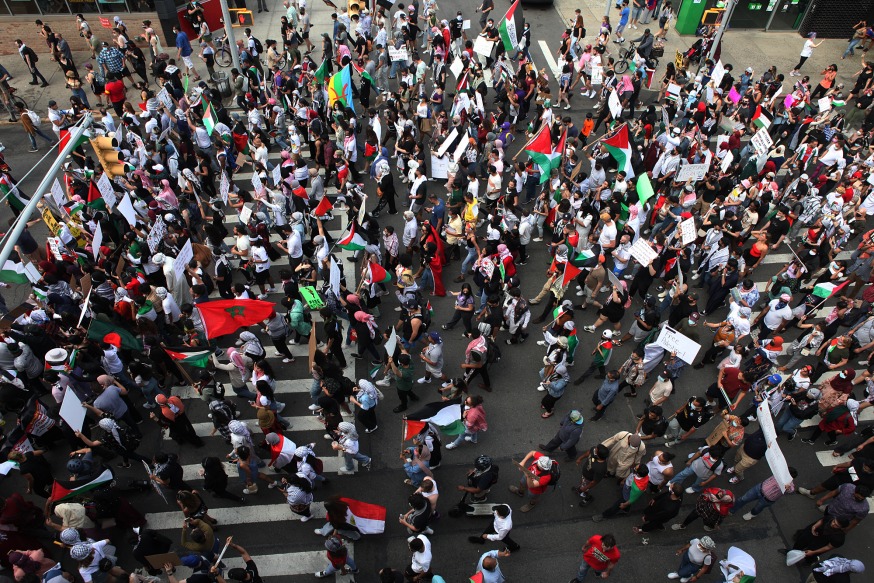
Thousand marched down Queens Boulevard in Sunnyside Saturday in a display of solidarity for Palestinians (Photo: Christina Santucci)
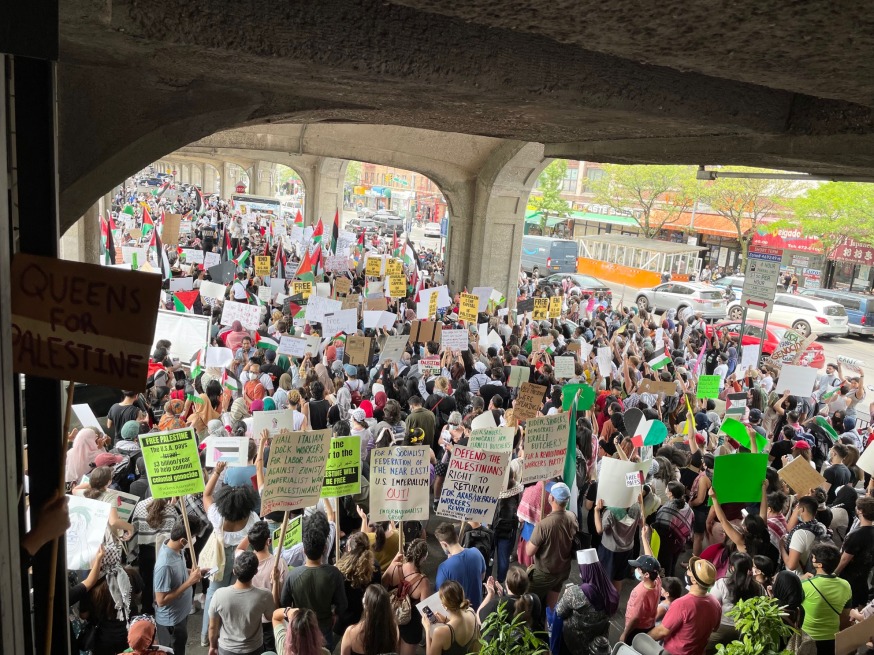
Rally goers met up at 46th Street and Queens Boulevard before marching to Astoria (Photo: Queens Post)
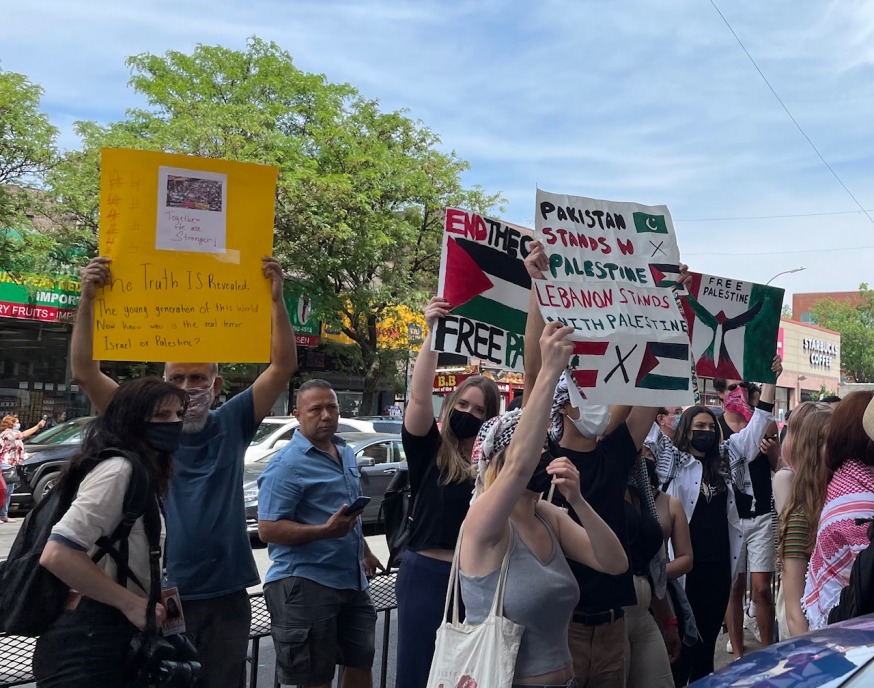
Rally goers in Sunnyside Saturday (Queens Post)
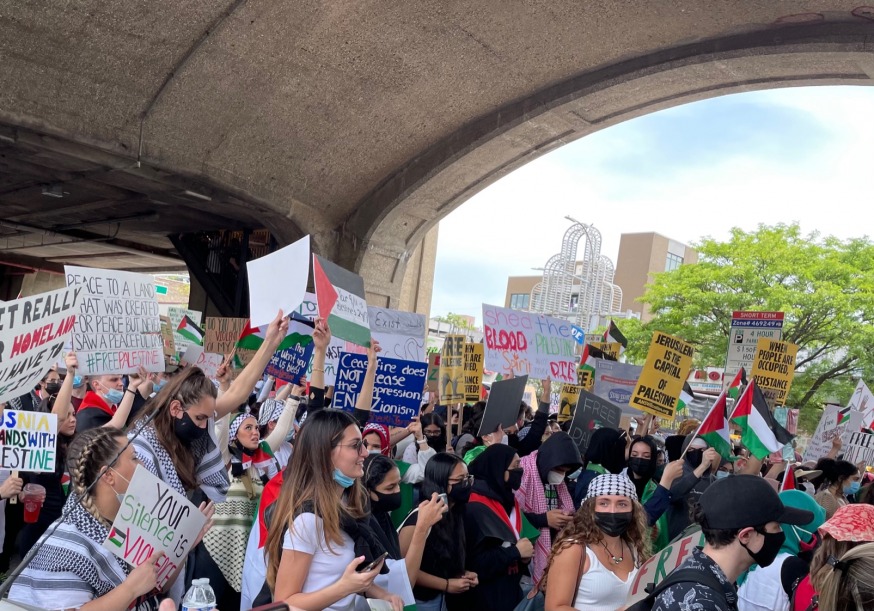
Rally goers in Sunnyside Saturday (Queens Post)
3 Comments

The tit-for-tat fighting can only stop when two contiguous states — Israel and Palestine — recognize each other. Palestine claim to nationhood is balanced by the necessity of a Jewish refuge (confirmed by rising anti-Semitism).
Americans have very short memories.
https://youtu.be/KuL4NVZog1g
This is the Book of 1695 written by Hadriani Relandi (1676-1718), Dutch Orientalist, Historian and Cartographer.
His conclusions follow:
Not one settlement in the Land of Israel has a name that is of Arabic origin.
Most of the settlement names originate in the Hebrew, Greek, Latin or Roman languages. In fact, till today, except to Ramlah, not one Arabic settlement has an original Arabic name. Till today, most of the settlements names are of Hebrew or Greek origin, the names distorted to senseless Arabic names. There is no meaning in Arabic to names such as Acco (Acre), Haifa, Jaffa, Nablus, Gaza, or Jenin and towns named Ramallah, El Halil and El-Kuds (Jerusalem) lack historical roots or Arabic philology. In 1696, the year Relandi toured the land, Ramallah, for instance, was called Bet’allah (From the Hebrew name Beit El) and Hebron was called Hebron (Hevron) and the Arabs called Mearat HaMachpelah El Chalil, their name for the Forefather Abraham.
Most of the land was empty, desolate.
Most of the land was empty, desolate, and the inhabitants few in number and mostly concentrated in the towns Jerusalem, Acco, Tzfat, Jaffa, Tiberius and Gaza. Most of the inhabitants were Jews and the rest Christians. There were few Muslims, mostly nomad Bedouins. Nablus, known as Shchem, was exceptional, where approximately 120 people, members of the Muslim Natsha family and approximately 70 Shomronites, lived.
In the Galilee capital, Nazareth, lived approximately 700 Christians and in Jerusalem approximately 5000 people, mostly Jews and some Christians.
The interesting part was that Relandi mentioned the Muslims as nomad Bedouins who arrived in the area as construction and agriculture labor reinforcement, seasonal workers.
In Gaza for example, lived approximately 550 people, fifty percent Jews and the rest mostly Christians. The Jews grew and worked in their flourishing vineyards, olive tree orchards and wheat fields (remember Gush Katif?) and the Christians worked in commerce and transportation of produce and goods. Tiberius and Tzfat were mostly Jewish and except of mentioning fishermen fishing in Lake Kinneret — the Lake of Galilee — a traditional Tiberius occupation, there is no mention of their occupations. A town like Um el-Phahem was a village where ten families, approximately fifty people in total, all Christian, lived and there was also a small Maronite church in the village (The Shehadah family).
No Palestinian heritage or Palestinian nation.
The book totally contradicts any post-modern theory claiming a “Palestinian heritage,” or Palestinian nation. The book strengthens the connection, relevance, pertinence, kinship of the Land of Israel to the Jews and the absolute lack of belonging to the Arabs, who robbed the Latin name Palestina and took it as their own.
In Granada, Spain, for example, one can see Arabic heritage and architecture. In large cities such as Granada and the land of Andalucía, mountains and rivers like Guadalajara, one can see genuine Arabic cultural heritage: literature, monumental creations, engineering, medicine, etc. Seven hundred years of Arabic reign left in Spain an Arabic heritage that one cannot ignore, hide or camouflage. But in Israel there is nothing like that! No names of towns, no culture, no art, no history, and no evidence of Arabic rule; only huge robbery, pillaging and looting; stealing the Jews’ holiest place, robbing the Jews of their Promised Land. Lately, under the auspices of all kind of post-modern Israelis — also hijacking and robbing Jewish history.
Two peoples, two states–a Palestinian state, including East Jerusalem as its capital, contiguous with Israel. To call for one state (“from the river to the sea”) denies the right of the Jewish people to a refuge in a world of accelerating anti-Semitic violence.